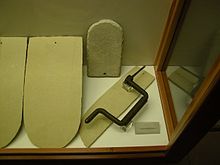The pinch pocket is a roof stone that is made from slab of limestone in the style of beaver tail .
The pinch pocket was first used in 1828 as lime slabs for roofing. The Eichstatt master glazier Josef Weittenhiller (* 1786; † January 7, 1862) was the inventor of the Zwicktasche. The Zwicktaschen are made from Solnhofen limestone , which is extracted in quarries around Solnhofen . Pinch-pocket roofs are widespread especially in the Altmühltal area , but there are also some more distant areas, such as in Schweinfurt , for example, buildings covered with pinch-pockets.
Manufacturing
The slabs obtained in the quarry, which are about 2 cm thick, are broken into the approximate shape of a brick and trimmed. The final shape of a brick is drawn using a template and the contour is brought into the shape using the nippers invented by Weitenhiller. A hole is drilled on the upper side of the pinch pocket with a pinch bit, through which a wire pin is driven into the rafters when roofing .
The name of the brick made of natural stone can be traced back to the way it is manufactured: With the help of special pliers, they are pinched into the desired shape, similar to the beaver tail brick . This is where the term "tweak" comes from. Pinch pockets can be reused, just like normal lime slabs. The quality is examined with the help of a sound test: if the pinch pockets sound light, they can still be used. A dull sound is an indication of fine hairline cracks or natural layers in the plate that can peel off.
This invention made quarries in the Eichstätter area, whose slabs were up to 2 cm thick, economically interesting again.
history
In 1836 the city of Eichstätt secured the right to manufacture the "Zwicktaschen" and committed itself to paying Weitenhiller one guilder and 30 kreuzers for every 1000 Zwicktaschen sold. In the same year the city granted the owner of the Harthof estate on the Blumenberg near Eichstätt the sole right to manufacture and sell Zwicktaschen. Since the demand was very high, the Eichstätter district of Blumenberg was founded for the workers near these quarries. In 1840 the manufacturing rights were sold to Johann Baptist Fellerer, who had to pay one guilder and 45 kreuzer to the city of Eichstätt. In 1841 the municipality of Wintershof sued the city of Eichstätt to break the privilege to manufacture the Zwicktaschen. However, she lost in court.
Roofing
With the roof covering, two regularly overlapping layers are sufficient for sealing. With the help of wire pins that are punched through the hole drilled with the pinch pocket drill , not only flat, but also steep roof structures can be achieved.
See also
Individual evidence
- ↑ Solnhofen slabs and Jura marble: the economic history. solnhofen-fossilienatlas.de, accessed on March 29, 2016 .
